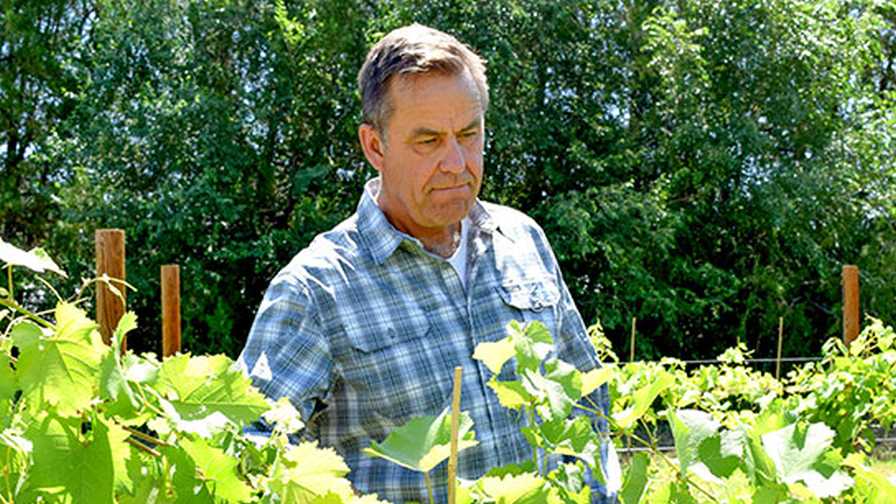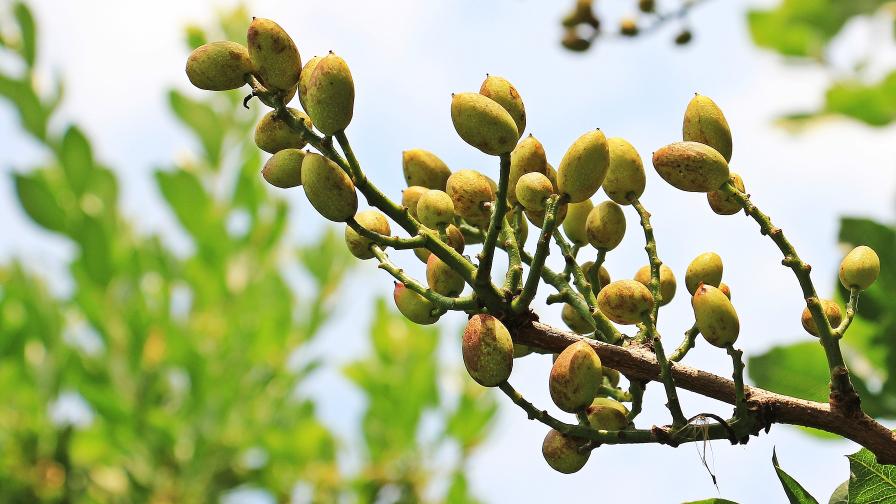Table Grapes on the Grow and Go in New Mexico

Researcher Dr. Gill Giese inspects leaves of table grapes in New Mexico.
Photo courtesy of New Mexico State University
The state motto of New Mexico — “It grows as it goes” — speaks to the motion of a thunderbolt across the sky. Someday soon, the motto might just as well apply to a fruit that, with a push from researchers at New Mexico State University (NMSU), is gaining momentum of its own.
Table grapes, the third-most consumed fresh fruit in the U.S., behind bananas and apples, according to USDA, are being courted at NMSU, where a variety trial is being conducted to determine which of 15 cultivars will thrive in New Mexico’s climate.
According to Dr. Gill Giese, an Extension Viticulture Specialist with the Los Lunas Agricultural Science Center at NMSU, the potential is “substantial” to incorporate table grape growing into New Mexico agriculture, given the fact the per capita consumption of table grapes per year in the U.S. is about 8 pounds.
“It was our thought that table grapes might fit into existing vegetable operations, such as those focused on chile and/or onion, as well as augment small, diversified farming endeavors and those of current wine grape producers,” Giese says.
The match seems logical.
No Humidity, Lots of Sun
New Mexico’s climate is dry, which greatly reduces the occurrence and severity of fungal diseases. “This translates to a great marketing advantage,” Giese says, “as consumers turn away from chemically dependent crops,” particularly ones that are purchased as “luxury” items, such as wine, or that they consume directly with their families and children, such as table grapes.
Grapes are relatively drought-tolerant and, with a modicum of irrigation, Giese says, can thrive. “Although table grapes typically have more water applied compared to wine grapes, they are still a much less ‘thirsty’ relative to many other crops, including pecans,” he says.
Finally, the state has plenty of sunshine. “This has a huge impact on grapevine physiology,” Giese says. “With bright sunlight, the buds are more fruitful, and actually UV light can deter some fungal pathogens, such as powdery mildew.”
Although the current number of table grape growers in the state is unknown, Giese says, most table grape producers are small and market directly through farmers’ markets.
“The in-state market is substantial, given that nearly 100% of the table grapes consumed in the state are transported here, either from South America or California,” Giese says. “With the recent disruptions in the food supply chain, it is obvious that the more local, resilient, and responsive a food supply is, the better. This has all the benefits of local production: employment, increased reliability, local tax revenues, and likely increased quality and reduced environmental impact due to less transportation and storage requirements of locally sourced grapes.”
Several types of growers are ideal candidates, Giese says, including current vegetable producers in the southern part of state and small, diversified farmers statewide. “Also, I have had inquiries from investors looking to initiate table grape plantings,” he says.
Trial Parameters
NMSU’s trial comprises 15 cultivars. Some of the newer varieties are being used in the Central Valley production area of California and were recommended by University of California, Davis colleagues who work with growers there. Other cultivars have been around for years, Giese says, and are recognized by consumers such as ‘Thompson Seedless’. Finally, some are hybrids that offer winter hardiness and different flavor profiles.
“The idea was to incorporate a wide array of genetics and those with and without current market appeal,” he says.
NMSU’s researchers are limiting their trial to Northern New Mexico because they are confident winter temperatures in the Las Cruces area are warm enough to consistently support grape production. However, Giese says, winter cold is a big factor, limiting successful grape production in most areas of the state, “and this aspect will be thoroughly tested at more northerly sites.”
Vine establishment and performance will be measured by season’s end and this winter. Some previously established vines will provide some fruit this fall, with which NMSU will do limited consumer preference surveys at farmers’ markets, and, pandemic restrictions notwithstanding, at commercial retail outlets.
“This will help us gauge consumer desires and likelihood of them purchasing New Mexico-grown table grapes,” Giese says. “But more long-term, we should get a small crop next year and a full crop in 2022 that will provide information on vine survivability, cropping levels, berry composition/quality, and consumer acceptance.”










